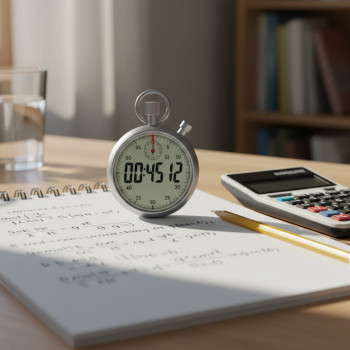Why Mood Tracking Matters for AP Students
If you’ve ever sat down to study and wondered why some afternoons feel productive while others drag, you’re not alone. For students preparing for AP exams, understanding the link between mood and study output isn’t just self-help fluff — it’s a practical way to optimize study time, boost retention, and reduce the last-minute panic that comes with exam season.
In this article we’ll explore why mood tracking works, how to set up a simple system, what patterns to look for, and how to turn insights into action. Along the way you’ll find examples, a template table to record your findings, and suggestions for routines that respect both your brain and your schedule. We’ll also touch on how Sparkl’s personalized tutoring and AI-driven insights can slot into this approach for students who want one-on-one guidance and tailored study plans.

How Mood Influences Study Output: The Science (In Plain English)
Before we get into tracking, it’s helpful to understand the mechanics. Mood affects attention, working memory, motivation, and the ability to switch between tasks — all critical for studying. When your mood is positive and energized, you may find it easier to tackle complex problem-solving (like AP Calculus or Chemistry free-response questions). When you’re tired or anxious, your brain tends to favor low-effort tasks (reviewing flashcards) and struggles with deep focus.
That doesn’t mean you should only study when you’re happy — many students learn well during quiet, slightly melancholic times — but recognizing mood-dependent strengths makes your study time smarter, not longer.
Key Mood-State Effects on Study
- Positive, energized: Better for creative synthesis, essay planning, and tackling hard practice problems.
- Calm but tired: Good for passive review — re-reading notes, watching clarifying videos, or doing light practice.
- Anxious or stressed: Short sessions, active breathing, or quick problem sets can help; avoid high-stakes practice unless you first manage the anxiety.
- Distracted or scattered: Use structure: timed sprints, simple checklists, or 1-on-1 tutoring sessions that force accountability.
Set Up a Mood-Tracking Routine That Actually Sticks
Many students fail at mood tracking because the process feels like extra homework. The goal is to make it effortless and useful. Here’s a compact routine you can try for two weeks and tweak from there.
Daily Mood-Tracking Template (5 minutes)
- Morning: Rate your mood on a 1–10 scale and note one word (e.g., “groggy,” “focused”).
- Pre-study: Rate energy (1–10) and note how many hours you slept and any major distractions (phone, family, noise).
- Post-study: Record study duration, what you studied, perceived productivity (1–10), and a short observation (e.g., “best for problem sets”)
- Evening reflection (optional): Any lingering stressors or wins. Three words max.
Use a small notebook, a simple spreadsheet, or one of the many mood-tracking apps. The method matters less than consistency.
Practical Tip: Keep Entry Time Under 2 Minutes
If it takes longer than 2–3 minutes to log, you’ll stop. Use shorthand: single-word moods, abbreviations for subjects (e.g., “APUSH” for AP U.S. History), and simple numbers for ratings.
What Patterns to Look For
After 7–14 days, you’ll have enough data to spot patterns. Don’t expect dramatic epiphanies — patterns are often subtle. Here are common signals and what they might mean for your study strategy.
Common Patterns and Interpretations
- High morning mood → high creative output: If you’re sharp in the morning, schedule essays or concept mapping then.
- Afternoon slump but evening rebound: Split study: light review in the afternoon, heavy problem solving in the evening.
- Consistent low mood on weekends: Might signal burnout. Reduce study intensity and prioritize sleep or social time.
- Anxiety before timed practice: Practice relaxation techniques before tests; start with low-pressure timed drills to build tolerance.
- Long sessions but low output: You might be logging hours but not focused minutes. Try Pomodoro sprints or 1-on-1 tutoring check-ins.
Case Example
Meet Alex, an AP Biology student. Over two weeks, Alex notices that on days rated 8–9 in the morning, practice exam sections completed doubled compared to days rated 4–5. Alex rearranges the schedule: mornings for practice exams, evenings for flashcard review and lecture videos. Within three weeks, Alex reports a 20% increase in timed section completion and more confidence during simulated exams.
Record and Analyze: A Simple Table to Find Trends
Here is a compact table you can copy into a spreadsheet or print out. Fill a row each day and review weekly.
| Date | Morning Mood (1–10) | Sleep Hours | Study Topic | Study Time (min) | Productivity (1–10) | Notes / Observations |
|---|---|---|---|---|---|---|
| 2025-10-01 | 7 | 7 | AP Calculus — Practice FRQ | 60 | 8 | Best in morning; deep focus |
| 2025-10-02 | 5 | 6 | APUSH — Read chapter | 45 | 5 | Distracted; phone notifications |
| 2025-10-03 | 9 | 8 | AP Physics — Problem Set | 90 | 9 | High energy; tackle tough problems |
After a week, compute averages: average morning mood, average productivity, and average sleep. Comparing these values across weeks helps you see correlations (e.g., sleep >7.5 hours correlates with productivity >7).
Turn Patterns Into a Smarter Study Plan
Finding a pattern is only half the job. The power is in applying that insight:
Actionable Strategies
- Time block by mood: Reserve mornings for synthesis (essays, conceptual mapping) if your data shows morning strength; reserve low-energy slots for repetition and flashcards.
- Adjust session lengths: On distracted days, do 25–35 minute Pomodoro sprints instead of marathon sessions.
- Prioritize sleep and recovery: If low sleep correlates with poor productivity, protect bedtime like an exam.
- Use targeted practice when anxious: Brief low-stakes quizzes and guided review can rebuild confidence before full practice tests.
- Schedule accountability checks: Book a weekly 1-on-1 session with a tutor (like Sparkl’s personalized tutoring) to review weak areas and recalibrate your plan.
Tools That Make Mood Tracking Useful (Without Overcomplicating)
Tools should reduce friction. Here are options ranked by simplicity:
Low-Tech
- Paper notebook or bullet journal: Quick, private, and tactile.
- Sticky notes: One per day with mood and top study goal.
Mid-Tech
- Spreadsheet (Google Sheets): Easy to chart averages and spot trends.
- Mood + Habit apps: Many allow quick entries and export to CSV.
High-Tech
- Dedicated mood-tracking apps with reminders and simple analytics.
- Combine app data with tutoring platforms: If you use a tutoring service like Sparkl, you can share patterns so tutors tailor sessions (for example, putting heavy practice in times when you’re naturally sharper).
When Patterns Reveal Bigger Issues
Not every pattern is about tweaking your schedule. Sometimes the data points to something deeper.
Warning Signs
- Consistently low mood and low productivity for several weeks — might indicate burnout or depression; talk to a trusted adult or school counselor.
- Big swings in mood tied to external stressors (family, health) — consider stress management strategies and inform your study plan.
- Severe anxiety before tests that persists despite preparation — ask for targeted help, like guided practice or a tutor who can coach test-day strategies.
Remember: mood tracking is diagnostic, not prescriptive. It helps you ask better questions and find better solutions.
Sample Weekly Plan Based on Mood Patterns
Below is an example week for a hypothetical AP student, Mira, who found she’s most productive between 8–11am and again 7–9pm, with an afternoon dip.
| Time | Monday | Wednesday | Friday |
|---|---|---|---|
| 8:00–11:00am | AP Chemistry: Full problem set | AP English: Draft practice essay | AP Calculus: Timed FRQ practice |
| 12:00–3:00pm | Light review; walk break | Group study (short) | Video lecture and notes |
| 7:00–9:00pm | Flashcards; spaced repetition | Practice multiple-choice sections | 1-on-1 tutor check-in (Sparkl) for targeted weak points |
This plan capitalizes on peak energy and uses lower-energy times for consolidation and restorative activities.
How to Use Mood Tracking With Tutoring
Pairing mood tracking with tutoring amplifies results. When tutors know your patterns, they can tailor sessions: schedule intensive problem-solving when you’re sharp, use evenings for review, and focus on anxiety-management techniques before timed practice.
If you choose a service like Sparkl’s personalized tutoring, mention your mood-tracking notes. Tutors can then prepare targeted lesson plans, time practice to align with your best periods, and provide AI-driven insights that flag persistent weak areas — saving you time and reducing frustration.
Real-World Examples: Small Changes, Big Gains
Here are two short, real-world style examples to illustrate how pattern-based tweaks deliver results.
Example 1 — From Marathon to Sprints
Jamal used to study for three hours straight after school and felt exhausted and unproductive. His mood log showed deep fatigue around 4pm and a small rebound at 8pm. He switched to 30–40 minute focused sprints in the early evening, added a 20-minute break, and moved heavy problem sets to the weekend mornings when his mood was highest. Result: same total study time, but better retention and higher practice-test scores.
Example 2 — Managing Test Anxiety
Priya noticed severe anxiety before practice ACT sections (which she used for AP test timing). She began short mindfulness exercises and 10-minute low-stakes quizzes two days before bigger timed runs. After three weeks, her anxiety decreased and timed-practice accuracy improved. She also worked with a tutor from Sparkl who taught pacing strategies tailored to her temperament.
Common Pitfalls and How to Avoid Them
- Over-tracking: Too much data creates analysis paralysis. Track the essentials and review weekly.
- Rigid rules: Patterns guide, but life happens. Keep plans flexible and compassionate.
- Ignoring sleep and nutrition: Mood tracking without lifestyle adjustments limits gains.
- Blaming yourself: Patterns are neutral information — not moral judgment.
Putting It All Together: A 30-Day Challenge
Want a guided experiment? Try this 30-day challenge:
- Days 1–3: Baseline — track mood, sleep, and study output without changing routines.
- Days 4–10: Identify two recurring patterns (e.g., “mornings are best”) and test small shifts (move one heavy task to mornings).
- Days 11–20: Implement a weekly plan aligned to your best periods. Add one accountability checkpoint each week (a friend, teacher, or a Sparkl tutor session).
- Days 21–30: Evaluate what worked. Keep the habits that improved productivity and drop what didn’t. Record a short reflection at day 30.
After 30 days you’ll have meaningful data and practical routines that suit your brain.

Final Thoughts: Small Patterns, Big Returns
Mood tracking isn’t a magic bullet, but it’s one of the most underused strategies for students preparing for AP exams. It makes invisible patterns visible and turns guesswork into informed decisions. When you know the times of day you function best, what derails your focus, and how your mood interacts with different tasks, you can study smarter — not just harder.
If you’re looking for extra support, consider complementing mood tracking with tailored tutoring. Services like Sparkl offer 1-on-1 guidance, expert tutors, and AI-driven insights that can incorporate your mood data into a personalized study plan. That combination — your self-knowledge plus targeted instruction — is a powerful way to improve output and confidence as AP season approaches.
Start Small, Iterate, and Be Kind to Yourself
Begin with a simple two-week log, make one change, and see how it affects your output. Celebrate small wins (a focused 45-minute session, a calm test run) and remember that progress is often incremental. The goal isn’t perfection; it’s finding a rhythm that helps you learn more effectively, reduces stress, and makes the road to AP success feel a little more predictable.
Parting Tip
Carry your mood log with the same respect you’d give a practice test — it’s data about your learning life. Use it to plan, not to punish. With steady tracking, thoughtful interpretation, and targeted support when needed, you’ll find patterns that unlock better study days and stronger AP performance.
Good luck — and remember, the best plans are the ones you can actually keep.




















No Comments
Leave a comment Cancel